人教版七年级上册英语英语语音
- 格式:docx
- 大小:41.64 KB
- 文档页数:19
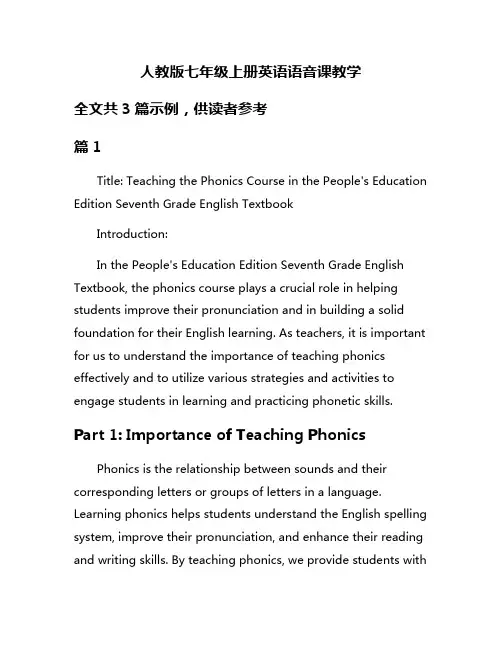
人教版七年级上册英语语音课教学全文共3篇示例,供读者参考篇1Title: Teaching the Phonics Course in the People's Education Edition Seventh Grade English TextbookIntroduction:In the People's Education Edition Seventh Grade English Textbook, the phonics course plays a crucial role in helping students improve their pronunciation and in building a solid foundation for their English learning. As teachers, it is important for us to understand the importance of teaching phonics effectively and to utilize various strategies and activities to engage students in learning and practicing phonetic skills.Part 1: Importance of Teaching PhonicsPhonics is the relationship between sounds and their corresponding letters or groups of letters in a language. Learning phonics helps students understand the English spelling system, improve their pronunciation, and enhance their reading and writing skills. By teaching phonics, we provide students withthe necessary tools to decode and encode words accurately, which is essential for their overall language development.Part 2: Strategies for Teaching Phonics1. Start with the basics: Introduce the sounds of the English alphabet and phonetic rules systematically. Use visual aids, such as flashcards and charts, to help students visualize and remember the sounds and their corresponding symbols.2. Practice, practice, practice: Provide students with ample opportunities to practice phonetic skills through activities such as word recognition games, word building exercises, and tongue twisters. Encourage students to listen carefully and repeat after you to improve their pronunciation.3. Incorporate multimedia resources: Utilize audio and video materials to expose students to authentic English pronunciation and intonation patterns. Play recordings of native speakers to help students mimic the correct sounds and rhythms of spoken English.4. Make it fun: Engage students in interactive and hands-on activities to make learning phonics enjoyable and engaging. Use songs, rhymes, and storytelling to create a dynamic learningenvironment that promotes active participation and reinforces learning.Part 3: Sample Lesson PlanTopic: Consonant Sounds (B, C, D)1. Warm-up (5 minutes)- Review the sounds of the letters B, C, and D with the class.- Practice pronouncing words that begin with these consonant sounds.2. Introduction (10 minutes)- Introduce the phonetic rules for the letters B, C, and D.- Demonstrate how to produce the sounds accurately.3. Practice Activities (20 minutes)- Word matching game: Match words with their corresponding initial sounds (e.g., bat, cat, dog).- Word building exercise: Create word families with B, C, and D (e.g., bad, cab, dig).4. Listening and Speaking Practice (15 minutes)- Listen to audio recordings of words with the consonant sounds B, C, and D.- Practice pronouncing the words accurately and pay attention to intonation patterns.5. Assessment (10 minutes)- Individual assessments: Ask students to pronounce words with B, C, and D and provide feedback on their pronunciation.- Group activities: Have students work together to create sentences using words with the target consonant sounds.6. Closure (5 minutes)- Review key concepts and encourage students to continue practicing phonics outside of the classroom.- Assign homework to reinforce learning, such as practicing pronouncing words with B, C, and D.Conclusion:Teaching the phonics course in the People's Education Edition Seventh Grade English Textbook requires effective strategies, engaging activities, and a focus on pronunciation accuracy. By incorporating a variety of teaching techniques and resources, we can help students develop their phonetic skills andbuild a strong foundation for their English language learning. As educators, it is our responsibility to ensure that students are equipped with the necessary tools to communicate effectively in English and to continue to strengthen their language skills in the future.篇2The teaching of phonetics in the People's Education Press's Seventh Grade English textbook is an important aspect of language learning. Phonetics involves the study of sounds in a language and how they are produced, perceived, and interpreted. In the English language, there are 44 sounds, which are made up of consonants and vowels. Understanding these sounds is crucial for clear communication and effective language acquisition.In the Seventh Grade English textbook, phonetics is introduced through a variety of activities and exercises. Students are taught how to pronounce individual sounds, as well as how to correctly pronounce words and sentences. They learn about the International Phonetic Alphabet (IPA), which is a system of symbols that represent the sounds of language. By using the IPA, students can accurately transcribe and reproduce English sounds.One of the key objectives of teaching phonetics in the Seventh Grade English textbook is to help students improve their listening and speaking skills. By developing their ability to discriminate between different sounds and produce them accurately, students can enhance their overall language proficiency. Phonetics also plays a role in helping students understand spelling patterns and etymology, as many English words are derived from different languages and have specific pronunciation rules.In addition to the theoretical aspects of phonetics, the Seventh Grade English textbook also includes practical exercises and activities to reinforce learning. Students may engage in listen and repeat exercises, where they listen to a native speaker pronounce a word or phrase and then repeat it back. They may also practice minimal pairs, which are pairs of words that differ by only one sound. By comparing and contrasting these pairs, students can hone their listening and pronunciation skills.Overall, the teaching of phonetics in the People's Education Press's Seventh Grade English textbook is essential for helping students develop their language proficiency. By mastering the sounds of English and learning how to produce them accurately, students can communicate more effectively and confidently inboth spoken and written contexts. Phonetics serves as a foundation for language learning and lays the groundwork for future language acquisition and fluency.篇3Teaching English phonetics in the first semester of Grade 7 is an important and interesting part of English language education. It lays a solid foundation for students' English learning in the future, helping them to improve their pronunciation, listening, and speaking skills. In this article, I will introduce the teaching content, methods, and strategies of teaching English phonetics in the first semester of Grade 7.Content:In the first semester of Grade 7, English phonetics mainly focuses on basic pronunciation, including consonants, vowels, diphthongs, and intonation. Students will learn how to pronounce English sounds accurately and fluently, as well as how to distinguish between similar sounds. They will also study word stress, sentence stress, and intonation patterns, which are essential for speaking English naturally and effectively.Methods:1. Listening and imitation: Listening to model pronunciation and imitating native speakers is an effective way to practice English phonetics. Teachers can play recorded audio materials or use multimedia resources to help students familiarize themselves with English sounds and intonation patterns.2. Phoneme drilling: Phoneme drilling is a technique where students practice pronouncing individual sounds repeatedly to improve their articulation and accuracy. Teachers can provide phonetic exercises and drills for students to practice in class or at home.3. Minimal pairs: Minimal pairs are pairs of words that differ by only one sound, such as "pat" and "bat." Students can practice distinguishing between minimal pairs to improve their ability to hear and produce English sounds accurately.4. Pronunciation games: Pronunciation games are a fun way to engage students in learning phonetics. Teachers can organize games like phonetic bingo, word stress relay, or sentence stress guessing to make phonetics lessons more interactive and enjoyable.Strategies:1. Create a supportive learning environment: Teachers should create a supportive and encouraging atmosphere in the classroom to help students feel comfortable practicing English phonetics. Positive reinforcement and corrective feedback can motivate students to improve their pronunciation skills.2. Provide individualized feedback: During pronunciation practice, teachers should provide individualized feedback to help students identify and correct pronunciation errors. One-on-one guidance and modeling can be more effective in addressing students' specific needs.3. Use multimedia resources: Multimedia resources such as audio recordings, videos, and interactive apps can enhance students' learning experience and expose them to authentic English pronunciation. Teachers can incorporate multimedia resources into their lessons to help students develop their listening and speaking skills.In conclusion, teaching English phonetics in the first semester of Grade 7 is an essential component of English language education. By focusing on basic pronunciation, using effective teaching methods, and implementing strategies to support students' learning, teachers can help students improvetheir pronunciation, listening, and speaking skills, laying a strong foundation for their English language development.。


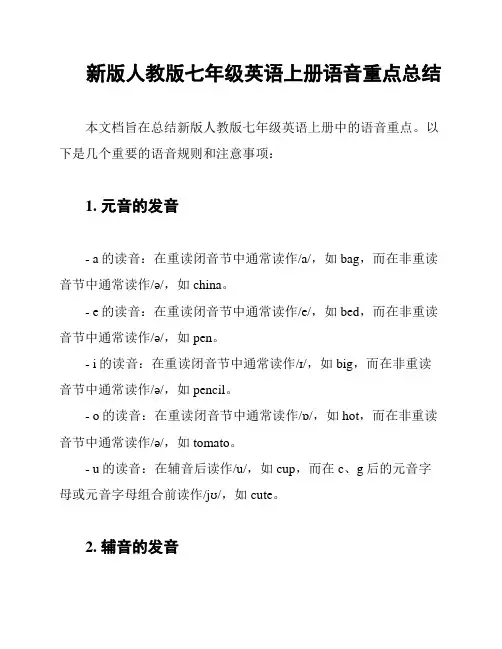
新版人教版七年级英语上册语音重点总结
本文档旨在总结新版人教版七年级英语上册中的语音重点。
以下是几个重要的语音规则和注意事项:
1. 元音的发音
- a的读音:在重读闭音节中通常读作/a/,如bag,而在非重读音节中通常读作/ə/,如china。
- e的读音:在重读闭音节中通常读作/e/,如bed,而在非重读音节中通常读作/ə/,如pen。
- i的读音:在重读闭音节中通常读作/ɪ/,如big,而在非重读音节中通常读作/ə/,如pencil。
- o的读音:在重读闭音节中通常读作/ɒ/,如hot,而在非重读音节中通常读作/ə/,如tomato。
- u的读音:在辅音后读作/u/,如cup,而在c、g后的元音字母或元音字母组合前读作/jʊ/,如cute。
2. 辅音的发音
- th的读音:在单词的开头或重读音节中,th通常读作/θ/,如this;在非重读音节中通常读作/ð/,如then。
- s的读音:在词尾读作/s/,如cats,而在词尾加-es时读作/ɪz/,如boxes。
- ch的读音:通常读作/tʃ/,如China。
- sh的读音:通常读作/ʃ/,如sheep。
3. 重读音节和非重读音节
- 重读音节:在单词中读音相对较重的音节。
在重读音节中,
元音的发音符合上述规则。
- 非重读音节:在单词中读音相对较轻的音节。
在非重读音节中,元音的发音通常读作/ə/。
以上是新版人教版七年级英语上册语音重点总结。
希望对您有
帮助。

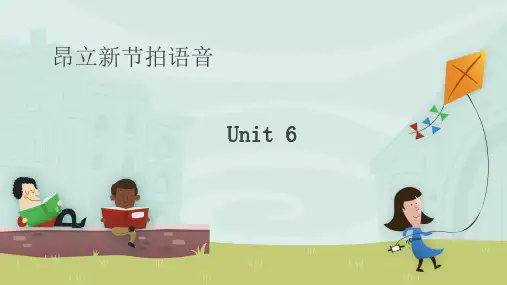

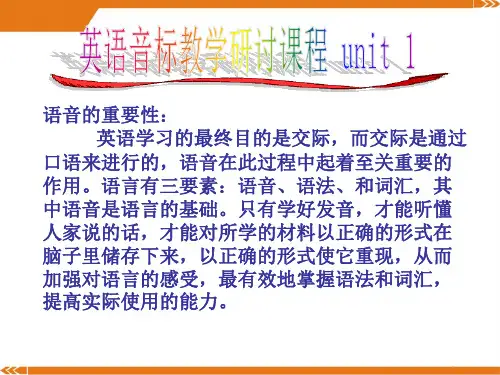
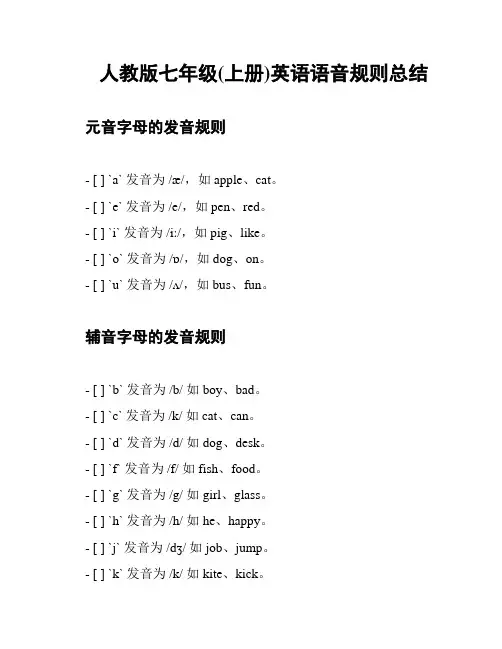
人教版七年级(上册)英语语音规则总结元音字母的发音规则- [ ] `a` 发音为 /æ/,如 apple、cat。
- [ ] `e` 发音为 /e/,如 pen、red。
- [ ] `i` 发音为/iː/,如 pig、like。
- [ ] `o` 发音为 /ɒ/,如 dog、on。
- [ ] `u` 发音为 /ʌ/,如 bus、fun。
辅音字母的发音规则- [ ] `b` 发音为 /b/ 如 boy、bad。
- [ ] `c` 发音为 /k/ 如 cat、can。
- [ ] `d` 发音为 /d/ 如 dog、desk。
- [ ] `f` 发音为 /f/ 如 fish、food。
- [ ] `g` 发音为 /g/ 如 girl、glass。
- [ ] `h` 发音为 /h/ 如 he、happy。
- [ ] `j` 发音为 /dʒ/ 如 job、jump。
- [ ] `k` 发音为 /k/ 如 kite、kick。
- [ ] `l` 发音为 /l/ 如 letter、like。
- [ ] `m` 发音为 /m/ 如 man、mom。
- [ ] `n` 发音为 /n/ 如 nice、no。
- [ ] `p` 发音为 /p/ 如 pen、pig。
- [ ] `q` 发音为 /kw/ 如 question、quick。
- [ ] `r` 发音为 /r/ 如 red、rain。
- [ ] `s` 发音为 /s/ 如 sun、star。
- [ ] `t` 发音为 /t/ 如 tree、take。
- [ ] `v` 发音为 /v/ 如 van、very。
- [ ] `w` 发音为 /w/ 如 water、window。
- [ ] `x` 发音为 /ks/ 如 fox、box。
- [ ] `y` 发音为 /j/ 如 yellow、yes。
- [ ] `z` 发音为 /z/ 如 zoo、zero。
音标符号在英语中,使用音标符号来帮助规范发音。


初一英语上册专题1----语音知识点精讲:一、语音重点概念1.音节:说话的时候最小的语音单位,通常是一个元音加上一个或者是几个辅音构成的。
特殊情况:/l/ /m/ /n/的后面没有元音的时候可以和它前面的辅音构成一个音节。
2.开音节:元音字母发生本身的音(1)绝对开音节:以元音字母结尾并且发音。
(2)相对开音节:以元音字母+辅音字母+不发音的e 结尾3.闭音节:一个元音字母加上一个或者几个辅音字母结尾的音节。
课堂练习一、画出下列单词哪些是开音节,哪些是闭音节?go so no do he she we me she home gate fate face five nice rice home cat bag bed cake map desk cup big not开音节:_________________________________________________________闭音节:_________________________________________________________二、区分一下单词是单音节词,双音节词还是多音节词.heavy like culture favorite palace person short captain popular curly hobby yesterday application单音节:______________________________________________________双音节:______________________________________________________多音节:_______________________________________________________三、选出划线部分单词读音与其他三个不同的单词。
(10分)( ) 1.A.blow B.now C.know D.snow( ) 2.A.heavy B.breakfast C.great D. sweater( ) 3. A. near B. early C. dear D.hear( ) 4.A.party B. hard C. warm D. car( ) 5.A.August B. laugh C. autumn D. caught四(1-5题)找出每组中含有和给出单词相同元音的选项,并将字母标号填入答题卡相应位置上。
Lesson 1 语音知识纲要
、英语共有26 个字母(大小写形式)
、英语共有48 个音标(音素)
)元音(20 个):
单元音12 个:/i:/ /i/ /? / /e/ / ?/ /a:/ / ?:/ / ? / / ?:/ / ?/
/ ?:/ /?/
双元音8 个:/e?/ /a?/ /??/ /a?/ /??/ /e?/ /??/ / ??/ )辅音(28 个):
轻辅音:/p/ /t/ /k/ / f/ / θ / /s/ / ?/ /ts/ /t ?/ /tr/
浊辅
音:/b/ /d/ /g/ /v/ /e/ /z/ / ?/ /dz/ /d ?/ /dr/ 鼻音:
/m/ /n/ /?/
边音:
/r/
喉音:
/ h/
舌侧音:/ ?/
半元音:/ j/ / w/
Lesson 2 / i: / / i /
Lesson 3 / ? // e /
2. /? / 这个音是四个前元音中舌位最低、口形最大的。
发音时,舌尖轻轻抵住下齿,双唇向两边平伸,成扁
Lesson 4 / ? / / a: /
1. /?/ 这个音不能发成“阿”,要发得短促。
发音时,嘴张大到“阿”大小,舌尖抵下齿龈,
2. /ɑ:/ 这个音和汉语的“阿”非常相近,为扁唇音,是后元音中舌位最低、口形最大的音。
发音时,口腔纵向打开,舌部展平,舌中部微微下凹,要做到发音时对镜能看到自己的扁桃体。
且要注意单词中出现字母r 的卷舌音。
Lesson 5 / ?: / / ? /
Lesson 6 / u: / / u /
1. / u: / 是后元音中口形最小最紧的一个音。
发音时,双唇向前突起,舌后部向软腭抬起口
2. / u / 在发音时,双唇收圆,稍向前突出。
同时,舌身后缩,舌后部向软腭抬起,舌尖轻触下齿。
Lesson 7 / ? / / ?: /
1. / ?:/与中文的“饿”发音相似,用在重读音节。
发音时,口部微张至发“饿”的嘴形,舌尖抵
2. /?/ 则是英语中最短最轻的一个元音,用在非重读音节中。
发音时,嘴半张,舌身平放口中,口腔肌肉放松,
Lesson 8 / ei / / ai /
1. /ei/ 由/e/ 和/i/ 构成,,实际发音时,/e/ 的嘴形比单音时略小,一定注意前长后短,前
/ai/ 该音在发音过程中口形变动较大,由舌位最低的/a/ 滑动到舌位较高的/i/ ,第一个
Lesson 9 / ?i / / au /
该音在滑动过程中口形变化也较大,由舌位较低的滑动到舌位较高的,由大开口改为圆唇。
Lesson 10 / ?u / / i ? /
Lesson 11 /e ?/ / u ?/ 1. / e? / 该音由/ e/ 向/ ? /滑动,做到前长后短,前重后轻即可。
Lesson 12 /p/ /b/ / t / / d / / k / / g /
1. /p/ & /b/ 双唇闭合,憋住气,然后气流突然冲破唇阻碍,发出爆破声。
/p/ 是清辅音,送气但不振动声带,
2. /t/ & /d/ 舌尖(舌前部)抵住上齿龈根部,形成气流阻碍,然后气流突然冲破阻碍,
发出爆破音。
/t/ 是清辅音,送气但不振动声带,/d/ 是浊辅音,不送气但要振动声带。
3. /k/ & /g/ 舌后部抬起,舌前部贴着软腭,形成阻碍,然后气流突然冲出口腔,发出爆破音。
/k/ 是清辅音,送
Lesson 13 / s / / z / / ts / / dz /
1./s/ /z/ 舌尖贴近上齿龈,但是不要贴住,上下齿极其接近,但不能碰到一起。
气流从舌尖和齿龈形成的窄缝中通过,摩擦发音。
其中是清辅音,送气但不振动声带,是浊辅音,不送气,但是要振动声带。
Lesson 14 /f/ /v/
1. /f/ /v/ 上齿轻触下唇,造成气流阻碍,但是气流仍然可以从唇齿间的狭长通道中通过,摩擦发音。
/f/ 为清辅
Lesson 15 /?/ / ?/
1. /?/ / ?/ 舌前部向上齿龈根部抬起,但是不贴住上颚,应保持悬空。
同时,舌两侧贴住
上齿两侧,舌面下凹,形成一条狭长的通道。
气流从这条狭长的通道中通过,同时摩擦发音,/?/ 是清辅
Lesson 16 /t ?/ /d ?/
/t ?/ /d ?/ 发音时,舌前端抬起贴住上齿龈根部,形成气流阻碍,位置摆好之后,气流冲破阻碍,与硬腭摩擦发音,同时有爆破感,所谓称作破擦音。
/t ?/ 是清辅音,送气但不振动声带,/d ?/是浊辅音,发音时有微弱的气流
Lesson 17 / θ / /e/
1. / θ / /e/ 舌尖轻放在上下齿之间,气流从舌尖和上齿下部边缘的缝隙中通过,摩擦发音。
/ θ/是清辅音,送气
但不振动声带,/e/ 是浊辅音,不送气,但是要振动声带。
虽然舌尖
是放在上下齿之间,但实际上控制气流的部位只是舌面和上齿,下齿并没有进行摩擦,所以不能紧紧咬住舌头。
Lesson 18 / w / / j / / h /
1./w/ 发音时,双唇收圆,小而紧张,并向前突出,口形与元音/u/ 相似,但是气流通过双唇时略有摩擦,所以
2./j/ 发音时舌前部尽量向硬腭抬起,双唇扁平,气流从舌与硬腭的缝隙间通过,摩擦发音,且振动声带。
这个
3 ./h/ 口腔对气流不形成任何阻碍,气流自由地由声门通过,但是此时摩擦实际上非常轻微,绝对不能振动声
Lesson 19 / r / / tr / / dr /
1. /r/ 发音时,嘴型小、圆且紧张,同时舌尖尽量向后卷,但是不能和上颚有任何摩擦。
2. / tr / / dr / 发音时,舌身与发/ r / 音相似,舌尖贴硬腭,气流冲破阻碍做/ t/ 或/d/ 的发
音准备后立即发/ r / ,发音时声带不振动。
Lesson 20 / m / / n /
1. /m/ 发音时,双唇闭拢,形成气流阻碍,气流从鼻腔中通过,共鸣发声。
注意发音时嘴唇不能张开,否则就会
2. /n/ 这是我们通常说的前鼻音。
发音时,舌尖抵住上齿龈根部,形成气流阻碍,气流从鼻腔中通过,共鸣发音。
Lesson 21 / ? / / l /
1. /?/ 这是我们通常说的后鼻音。
发音时,软腭稍稍下垂,舌尖轻触下齿龈,舌根部稍稍上抬阻止气流从口腔通
2. /l/ 发音分为两种:清晰的/l/ 和模糊的/l/ 。
清晰的/l/ 出现在元音前,模糊的/l/ 在元音后,一般在词尾。
发
清晰的/l/ 时,舌尖抵住上齿龈根部,舌前向硬腭抬起,形成气流阻碍,气流从舌的两侧通过,所以叫舌侧音。
/l/ 是浊辅音,要振动声带。
这个音可以用汉
语中的“了”相似替代。
发模糊的/l/ 时,舌尖抵住上齿龈根部,舌面下凹,发音响亮。
注意此时舌尖不能动,只要舌尖一离开上齿龈根部,就变成了清晰的/l/ 。
模糊的/l/ 由。